
Mathematics and Financial Economics
Scope & Guideline
Innovating Financial Strategies through Mathematical Rigor
Introduction
Aims and Scopes
- Mathematical Modeling in Finance:
The journal extensively covers mathematical models applied to financial markets, risk management, and investment strategies. This includes stochastic modeling, optimization techniques, and game theory applications. - Risk Management and Insurance Economics:
Papers often explore models for managing financial risk, including insurance strategies and capital allocation under uncertainty, highlighting the importance of robust decision-making frameworks. - Dynamic Programming and Control Theory:
A significant focus is on dynamic programming methods in financial contexts, particularly in optimal control problems related to portfolio management and consumption-investment decisions. - Mean Field Game Theory Applications:
The journal features research that applies mean field game theory to economic and financial systems, addressing collective behaviors of agents and their implications for market dynamics. - Interdisciplinary Approaches:
There is a consistent emphasis on interdisciplinary research, integrating insights from economics, finance, and applied mathematics to tackle complex financial issues.
Trending and Emerging
- Mean Field Game Theory:
There is a notable increase in the application of mean field game theory, particularly in modeling interactions among agents in financial markets and their collective behaviors, which is crucial for understanding systemic risk. - Robust Optimization and Utility Maximization:
Emerging research on robust optimization techniques showcases a growing emphasis on developing strategies that perform well under uncertainty and model ambiguity, essential for real-world financial decision-making. - Dynamic Asset Allocation Strategies:
The trend towards dynamic asset allocation reflects the need for adaptive strategies that respond to changing market conditions and investor preferences, particularly in volatile environments. - Environmental and Social Governance (ESG) Factors:
Increasing attention to ESG factors indicates a shift towards integrating sustainability considerations into financial models, which is becoming increasingly relevant in investment decisions. - Advanced Risk Management Techniques:
The rise of complex risk management frameworks that incorporate systemic risk, contagion effects, and network analysis highlights a growing recognition of interdependencies in financial systems.
Declining or Waning
- Traditional Portfolio Optimization Techniques:
There seems to be a waning interest in classical portfolio optimization methods, as newer, more complex models incorporating dynamic and stochastic elements gain traction. - Static Risk Assessment Models:
Static models for risk assessment are becoming less prevalent, as researchers shift towards dynamic frameworks that better capture the evolving nature of financial markets. - Single-Asset Models:
Research focusing solely on single-asset models appears to be declining, as there is a growing trend towards multi-asset frameworks that consider interactions between various financial instruments. - Basic Economic Equilibrium Models:
Basic models of economic equilibrium are receiving less attention, with a preference for more nuanced approaches that incorporate factors such as market frictions and behavioral economics. - Deterministic Financial Models:
The use of deterministic models is decreasing, as stochastic models that account for uncertainty and variability in financial processes are favored.
Similar Journals

African Review of Economics and Finance-AREF
Championing Open Access to African Economic ResearchAfrican Review of Economics and Finance (AREF) is a distinguished academic journal dedicated to advancing knowledge in the fields of economics and finance within the African context. Published by PORTHOLOGOS PRESS, the journal aims to provide a platform for research that addresses critical economic and financial issues that affect Africa, promoting innovative solutions and fostering discussion among scholars and practitioners. With its ISSN 2042-1478 and E-ISSN 2410-4906, AREF has established itself as a vital resource for researchers, professionals, and students seeking to deepen their understanding of African economies. The journal’s commitment to open access ensures that its valuable research findings are readily available to a global audience, thereby enhancing visibility and engagement. Through rigorous peer-review processes and thoughtful editorial leadership, AREF contributes significantly to the discourse on economic development, policy analysis, and financial practices in the region.

Quantitative Finance and Economics
Advancing Knowledge in Quantitative Finance and EconomicsQuantitative Finance and Economics, published by the American Institute of Mathematical Sciences (AIMS), is a pioneering open-access journal committed to advancing the fields of finance and economics. Established to disseminate high-quality research, this journal has been an open-access platform since 2017, promoting wider accessibility to vital academic findings. It serves as a crucial resource for researchers and professionals alike, offering valuable insights through rigorous studies in quantitative methods that influence financial and economic decision-making. Although current Scopus rankings indicate emerging challenges, with a rank in the lower percentiles across various categories, Quantitative Finance and Economics strives to gain recognition by bridging theoretical frameworks with practical applications. The journal invites contributions that explore innovative quantitative techniques and their implications in contemporary economic scenarios, thus underscoring its role in shaping discourse and research in this critical sector.
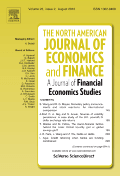
North American Journal of Economics and Finance
Driving innovation through impactful research.The North American Journal of Economics and Finance is a premier academic journal published by Elsevier Science Inc. since 1992, dedicated to advancing the field of economics and finance through rigorous research and scholarship. With an impressive impact factor and recognition in the Q2 category for Economics and Econometrics and Q1 for Finance as of 2023, this journal holds a significant position in the academic community, ranked #41 out of 317 in Finance and #100 out of 716 in Economics. The journal features high-quality, peer-reviewed articles that cover a broad range of topics, from theoretical frameworks to empirical analyses and practical applications. Though not an open-access platform, the journal provides valuable insights for researchers, practitioners, and students alike, promoting knowledge dissemination in the dynamic landscape of economic and financial studies. With its commitment to excellence, the North American Journal of Economics and Finance serves as an essential resource for those seeking to deepen their understanding of contemporary issues in these critical fields.
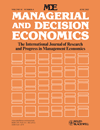
MANAGERIAL AND DECISION ECONOMICS
Unveiling New Horizons in Managerial EconomicsMANAGERIAL AND DECISION ECONOMICS is a highly regarded academic journal published by John Wiley & Sons Ltd that serves as a vital resource in the field of business and management. With an ISSN of 0143-6570 and an E-ISSN of 1099-1468, this journal has established itself as a prominent platform for disseminating cutting-edge research from its inception in 1980 through to 2024. Currently ranked in the Q2 category across multiple fields—including Business and International Management, Management of Technology and Innovation, Management Science and Operations Research, and Strategy and Management—it highlights significant contributions within these domains. The journal is based in the United Kingdom and contributes to the ongoing dialogue and development of innovative managerial practices driven by empirical decision-making research. Although the journal does not offer open access, it remains highly influential, with noteworthy Scopus rankings showing its strong impact within the scholarly community. Researchers, professionals, and students alike will find valuable insights and advancements in management science that inform and enrich their practices and academic pursuits.
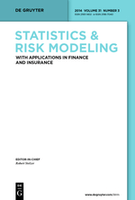
Statistics & Risk Modeling
Illuminating the path of statistical excellence in risk management.Statistics & Risk Modeling is a distinguished journal published by WALTER DE GRUYTER GMBH, focusing on the intricate relationships between statistical methodologies and risk assessment techniques. With a strong academic foundation, the journal has been an influential platform in its field since its inception, converging contributions from 1982 to 2002 and again from 2011 to 2024. This journal is currently ranked in the Q3 category in both Modeling and Simulation and Statistics and Probability, reflecting its commitment to advancing knowledge and promoting robust research in statistics, probability, and uncertainty analysis. Although it offers a traditional subscription model, its significant contribution to the community is underscored by its increasing visibility in Scopus rankings, where it stands in the 44th percentile for Decision Sciences and Statistics. By comprehensively addressing contemporary issues in statistical theory and its practical applications, Statistics & Risk Modeling serves as an essential resource for researchers, professionals, and students aiming to deepen their understanding of statistical science and its implications in risk management.

JOURNAL OF ECONOMICS AND BUSINESS
Empowering Scholars and Practitioners AlikeJOURNAL OF ECONOMICS AND BUSINESS, published by Elsevier Science Inc, stands as a leading platform for the dissemination of research in the fields of economics and business management. With an ISSN of 0148-6195, this journal is indexed in Scopus and boasts impressive rankings, including a position in the top 20% for both Finance and Economics and Econometrics. With a consistent publication history since 1978, it has become a vital resource for scholars and practitioners alike, providing insights into contemporary issues and emerging trends in the economic landscape. The journal, categorized in the Q2 quartile for both Business and Economics, invites rigorous research that advances theoretical and practical knowledge. While it operates under a subscription model, its notable impact factor reflects its significance and relevance in addressing critical questions within the business and economics domains. Whether you are a researcher, a business professional, or a student eager to deepen your understanding, the JOURNAL OF ECONOMICS AND BUSINESS is an essential resource for your academic and professional journey.
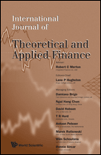
International Journal of Theoretical and Applied Finance
Pioneering insights for a complex financial landscape.International Journal of Theoretical and Applied Finance is a distinguished publication in the field of finance, serving as a critical platform for the dissemination of innovative research and theoretical insights since its inception in 2003. Published by World Scientific Publishing Co Pte Ltd in Singapore, this journal boasts an impressive Q2 ranking in the realms of Economics, Econometrics, and Finance (miscellaneous) and a solid Q3 status in Finance for 2023. With a commitment to advancing knowledge in the complex world of theoretical frameworks and applied financial practices, it welcomes original research articles, comprehensive reviews, and case studies that explore varied facets of finance. Researchers, professionals, and students benefit from the journal's rigorous peer-review process and an ever-expanding repository of knowledge, making it an indispensable resource in the financial academic community. The journal does not currently offer open access, reflecting its selective approach to publishing high-quality content aimed at a specialized audience.

FINANCE AND STOCHASTICS
Unlocking the Secrets of Stochastic FinanceFinance and Stochastics is a leading academic journal published by Springer Heidelberg, focusing on the intricate interplay of finance, probability, and statistics. With an impressive impact factor and ranked within the Q1 category in both finance and statistics, it serves as an essential resource for researchers and professionals seeking to advance their understanding of stochastic modeling in financial contexts. The journal has maintained a strong reputation since its inception, with contributions from renowned scholars worldwide. The editorial team prioritizes high-quality research that addresses contemporary challenges in financial mathematics and extends the boundaries of statistical methods. Nestled in the heart of Germany, Finance and Stochastics embraces a broad scope, inviting submissions that explore innovative approaches to economic theory and quantitative methodologies. This combination of rigorous academic standards and commitment to impactful research makes the journal a pivotal avenue for disseminating knowledge and fostering collaboration in the finance and statistics communities.
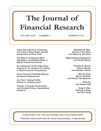
JOURNAL OF FINANCIAL RESEARCH
Charting New Territories in Financial InquiryThe JOURNAL OF FINANCIAL RESEARCH, published by WILEY, stands as a pivotal platform for disseminating innovative research in the fields of finance and accounting since its inception in 1978. With an ISSN of 0270-2592 and an E-ISSN of 1475-6803, this journal aims to address contemporary challenges and trends within the financial research landscape. It has achieved notable recognition, being placed in the Q2 category for both Finance and Accounting in the 2023 rankings, signifying its relevance and impact within the academic community. Although it does not currently offer open access, the journal is accessible through various academic databases, catering to a diverse audience of researchers, professionals, and students keen on advancing their knowledge and understanding of financial systems and methodologies. With an evolving scope that encompasses empirical studies, theoretical frameworks, and practical applications, the JOURNAL OF FINANCIAL RESEARCH is committed to contributing valuable insights into the complexities of financial practices and policies.

Decisions in Economics and Finance
Empowering Decision-Makers Through Rigorous ResearchDecisions in Economics and Finance, published by SPRINGER INT PUBL AG, is a leading journal in the fields of economics, econometrics, and finance, providing a critical platform for researchers, professionals, and students to disseminate their findings and insights. With an impressive impact factor positioned in the Q2 category for both Economics and Finance in 2023, this journal is recognized for its rigorous peer-reviewed process and impactful research contributions. The journal spans over areas of general economics and finance, emphasized by its Scopus rankings, which place it in the 68th and 50th percentiles respectively. Since its inception in 1997 and continuing through its conferred years, Decisions in Economics and Finance continues to foster innovative approaches to economic and financial decision-making while bridging theoretical and practical applications. While it currently does not offer Open Access options, its commitment to quality research and interdisciplinary collaboration makes it a vital resource for anyone engaged in these dynamic fields.